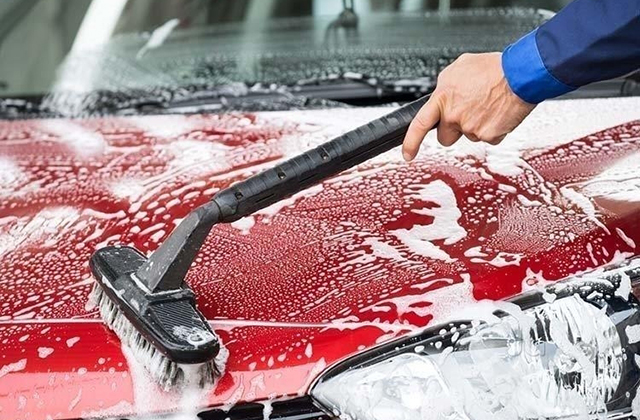Taking care of your car’s appearance doesn’t qualify as vanity, it’s smart vehicle ownership. You can hire a professional auto detailer to care for your car for $100 to $500 — or you can swipe their secrets, do it yourself and save some dough. Using the right car detailing supplies and tools is essential for auto detailers and shops.
There are a few professional organizations for detailers, like the National Association for Professional Detailing & Reconditioning (NAPDR) and the Professional Detailers Association, where you can find references for local detailers, but membership in either or any organization does not guarantee competence.
If you’re going to hire a detailer, ask a lot of questions, ask for references and to see sample work, and agree to a price in writing before the detailing work begins.
“There are no secrets in this business anymore,” said NAPDR Membership Chairman Randy Lowe, who also owns Randy’s Custom Detail in Salem, Oregon. With the free flow of information on the Internet, do-it-yourselfers have access to all of the tools and tricks of the trade available to the pros.
If you choose to detail your own ride, be prepared to spend a little bit of money gathering the proper tools and materials.
You may already have most of the right stuff handy in your garage; if you must gather everything from scratch, you might spend from $30 to $100 or more, depending on how extensive you want your detail job to be. AOL Autos: Most popular fuel-efficient cars
The most important material that you’ll need is already in your tool kit. For Lowe, the secret ingredient is hard work and elbow grease.
“Good detailing is 90% application and 10% product,” he said. “The best detailer can get decent results with decent products, but the worst detailer can’t get great results even with great products.” AOL Autos: 10 cars to keep you young
There are few automotive maintenance chores that are more satisfying, accessible to all skill levels and truly beneficial for your car than a good detail job. AOL Autos: Cars with the best resale value
We’ve collected the top secrets that will help you to get professional results, make your detailing more fun, more successful and easier. AOL Autos: 10 safest small cars
Secret #1: Use two buckets to wash
Detailers know that the two bucket method is the best way to get your exterior clean. Use one bucket to hold your clean suds, and another bucket to hold clean water. Before you dip your cleaning mitt into the clean suds, rinse it off in the clean water bucket and wring it dry.
Then, you’re always putting a clean mitt into the clean suds that will go on your car. If you only use one bucket, you’re just moving dirt off of your car, into your suds and back onto your car.
Some pros have started using the Grit Guard insert, a $9.99 tray that helps sediment settle to the bottom of your wash bucket, instead of getting stirred up in the water and recollected on your wash mitt. AOL Autos: Hybrids that will save you the most
Secret #2: Join the microfiber revolution
We’re living the microfiber revolution. Pro detailers use color-coded, task-specific microfiber cloths and towels for greater efficiency, lower friction and scratching and easier washing, rinsing and drying. Mike Pennington, director of training and consumer relations for Meguiars, emphasizes that it’s important to wash your microfiber as a separate load, not mixed in with the regular laundry and rags.
Microfiber will trap the lint from cotton towels, defeating the purpose of the wash. Use very little detergent and skip the fabric softener, which will coat the fibers and inhibit microfiber’s qualities. Double up on the rinse cycle, and your microfiber will perform at its best. Remove any labels and stitching before you use your towels to avoid scratching.
And remember, you get what you pay for — those cheapo packs of microfiber from the warehouse store are not nearly as good as the ones you can find at online specialty stores.
Secret #3: Detail your trim first
This tip comes from Jim Dvorak, a product specialist at Mothers Polish. He suggests using a trim protectant/restorer like Mothers’ Back to Black before waxing your paint. Wash and dry your vehicle, then apply the trim protectant.
The product will repel polish and wax that might otherwise stain your trim. Some pro detailers use masking tape to protect the trim during waxing — this application can help save time and cleanup.
Secret #4: Use a buffer to apply product, a towel to remove
Consumers sometimes get confused by the name of the tool, and use a power buffer to remove wax or polish from the painted surfaces of their cars. A buffer can leave erratic swirl marks in your clear coat and paint if used to remove product, that’s not what it’s for.
Use the buffer to apply wax, and then use a soft, dry cloth to remove it. You’ll avoid burning the paint or damaging the clear coat, and you’ll wind up with a thin, even coat of wax.
Secret #5: Get a dual action polisher
For just a little bit more than you’d spend on a good direct drive polisher and an orbital polisher, you can get the perfect blend of both tools with a dual action polisher like the Flex XC 3401 VRG, which retails for around $280.
Based in Stuttgart, Germany, Flex has been making tools since 1922, and has been building dedicated auto finish polishers since 1988. The XC 3401 VRG is detailer Randy Lowe’s favorite tool for exterior finishes. He says that it will handle 90% of the polishing chores you will encounter.
Meguiars’ Dual Action Polisher ($149) is a little more consumer friendly, and a little less expensive than the Flex. It doesn’t have the forced rotation, which keeps the tool moving even under a heavy load. Forced rotation is a great feature for an expert who knows how to use it; in inexperienced hands, it can do more harm than good.
Secret #6: Use a clay bar system
This secret may be out of the bag already, but it’s such a good one that it bears repeating. There’s no better way to remove surface contaminants from paint than with a good clay bar system. Pros have been using clay for years, and consumer versions have been on the market for at least a decade.
A good clay bar system includes a spray lubricant, usually a detailing spray, an 80 – 100 gram clay bar, and a towel. According to Mike Pennington from Meguiars, after washing and drying your car, you rub the clay bar on the paint to remove “bonded environmental contaminants” without removing paint thickness.
The smoother paint surface takes polishing and wax better, and extends the life of subsequent treatments. Meguiars’ Smooth Surface Clay Kit retails for $19.99; Mothers’ California Gold Clay Bar Paint Saving System is $19.95.
Secret #7: Use a plastic grocery bag to check the paint surface
Hers’s another tip from Jim Dvorak at Mothers. Once you have cleaned your paint’s surface of contaminants with a clay bar system or other cleaner, it’s important to make sure that you’ve really removed all the dirt before you seal the surface with wax.
Put your hand in an ordinary thin plastic grocery bag, and run it over the surface of the paint. The plastic bag will amplify any bumps and imperfections, so that you can go back and detail again. Keep rechecking until the surface is totally smooth, then polish (if necessary) and apply protective wax.
Secret #8: Dry your glass in two directions
Here’s a great tip from Meguiars’ Pennington: Dry your glass in two directions. Get into the habit of doing your final wipe of interior glass in a horizontal direction, and the final wipe on the exterior in a vertical direction.
Then, when you find the inevitable streak, you’ll instantly know whether it’s on the inside (horizontal) or the outside (vertical) of the glass. You’ll get perfectly clear glass without jumping in and out of the vehicle chasing that streak.
Secret #9: Brush it first
Pennington says that when it comes to cleaning interiors, mechanical agitation is always better than chemical intervention. That means that your first line of attack is a good brush.
For instance, before vacuuming your carpeting, de-mat the fibers by using a stiff nylon brush. Then, when you vacuum, the dirt will be free in the carpet, and will be much easier to extract. The same goes for door panels, though you’ll want to use a gentler brush. If more aggressive cleaning is necessary, start gently, use a gentle solution of fabric cleaner, and dry with a soft cotton cloth.
Secret #10: Make static electricity your friend
To remove stubborn pet hair from your car’s carpets, put on a pair of latex gloves (readily available in boxes of 100 from any home improvement store) and then rub your hand over the carpet. The static electricity caused by the latex glove will help bring the pet hair up to the surface of the carpet for easy removal by hand or vacuum.
Secret #11: Leave the headliner alone
According to Pennington, there’s one part of the car that detailers avoid if at all possible: the headliner. Even a little bit of agitation can cause the glue in a headliner to fail, causing way more problems than it is worth. Keep your ministrations to a minimum when it comes to cleaning, brushing and tending to the headliner fabric.
Take note if you positively must clean your headliner, use very little moisture, and never allow it to soak through the outer fabric.
Auto detailing can be a great way to bond with your car, and to make your automotive investment go farther, last longer and look better. Hopefully these top secrets will help you and your ride along the way.

